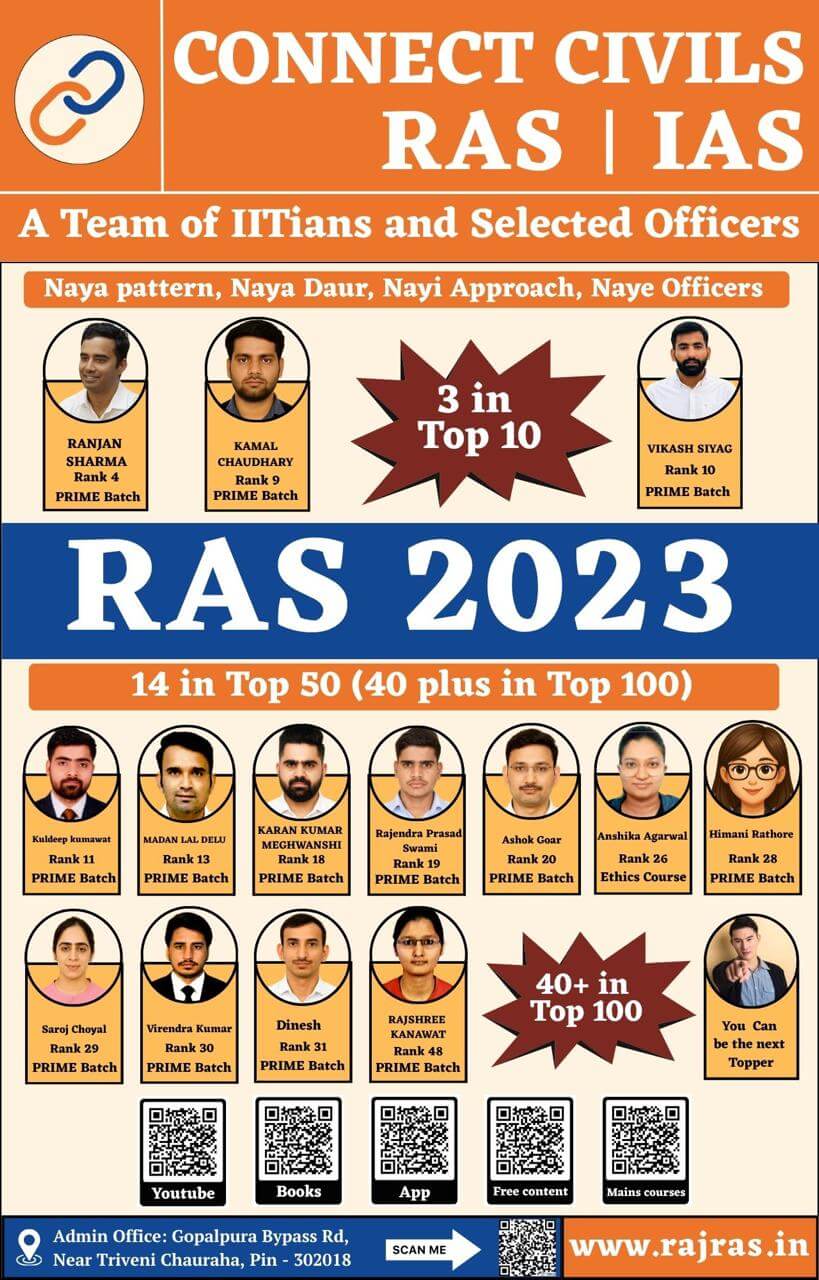Click here to download the schedule – English Medium | Hindi Medium
SUBJECT – BEHAVIOR
TOPIC – Learning and Motivation: Styles of learning, Models of memory, Causes of forgetting. Assessment of motivation | Stress and Management: Nature, Types, Sources, Symptoms, Effects, Stress Management, Promotion of Mental Health
For Hindi medium – Click here
Behavior PYQs – Click Here
Click on the question to see the model answer. Submit your answers below and complete the 90-day challenge for RAS Mains answer writing
Q1 Define Ebbinghaus Curve. 2M
Answer:
Ebbinghaus curve is the first systematic attempt to understand the nature of forgetting. It indicates that the rate of forgetting is maximum in the first nine hours,particularly during the first hour. After that the rate slows down and not much is forgotten even after many days.
(Hermann Ebbinghaus memorised lists of nonsense syllables and then measured the number of trials he took to relearn the same list at varying time intervals, observed that the course of forgetting follows a certain pattern.)
Q2 What is Stress? 2M
Answer:
The pattern of responses an organism makes to stimulus events that disturbs the equilibrium and exceeds a person’s ability to cope. It is neither a stimulus nor a response but an ongoing transactional process between the individual and the environment.
Hans Selye, the father of modern stress research, defined stress as “the nonspecific response of the body to any demand” that is, regardless of the cause of the threat, the individual will respond with the same physiological pattern of reactions.
Q3 What is the importance of mental health in the well-being of an individual? Briefly describe ways through which it can be promoted. 5M
Answer:
Importance of mental health: According to Central Disease Control and Prevention(CDCP) good mental health is linked to:
- Improved learning
- Creativity
- Higher levels of productivity
- Better social relationships
- Good physical health
- Increased life expectancy
- Cope with stress
Ways to promote mental health: According to WHO and National Institute of Mental Health (NIMH)
- Early childhood interventions
- School and workplace mental health programs i.e., manodarpan Initiative (Min. Of Education)
- Regular exercise
- Try a relaxing activity(meditation, muscle relaxation, or breathing exercises)
- Make sleep a priority
- Eat healthy, regular meals and stay hydrated
- Seek professional help(if distressing symptoms lasted more than 2 weeks)
- Foster a positive mindset: Cultivate gratitude, optimism, and self-compassion.
- Government initiatives: National Tele Mental Health Program-NTMHP, National Mental Health Program-NMHP
(The World Health Organization reports that India bears a burden of 2,443 disability-adjusted life years (DALYs) per 100,000 individuals as a result of mental health issues. Instances of mental health conditions in India have surged by 18%, while there is only 0.75 psychiatrists available per 100,000 population. This situation underscores a significant mental health challenge in the country.)
Q4 Describe 3 Stage Model of memory by Atkinson and Shiffrin. 5M
Answer:
Atkinson and Shiffrin’s model of memory also known as stage model of memory. This proposes the existence of three separate but sequentially linked memory systems.
| The sensory memory—The incoming information first enters the sensory memory; 1. Has a large capacity; 2. Very short duration, i.e. less than a second; 3. Information from all the senses are registered here as exact replica of the stimulus; 4. Often called sensory register. | The short-term memory—Information that is attended to enters the second memory store STM; 1. Holds small amount of information; Encoded acoustically; 2. Lost in less than 30 seconds unless rehearsed continuously. | The long-term memory— Information that survive the capacity and duration limitations of the STM enter the LTM ; 1. Has a vast capacity; 2. Permanent storehouse of all information; 3. Information that enters the long-term memory store is never forgotten (because it gets encoded semantically, i.e. in terms of the meaning that any information carries). |
Q5 Elaborate any one of the following themes in approximately 150 words : [RAS Mains 2018]
All’s well that ends well.
Answer:
All’s well that ends well
This proverb means that, no matter how one arrives at a certain outcome, if that outcome is a good one then everything is alright. Every matter gets started to reach an end. There is an end to everything. This end is certain. No one can stop it from happening. Nothing is permanent in this world. It may be life, maybe a movie or maybe any other chore. It is made for having an end. It is said that if the end is good then everything is good. No one is going to see how much effort you have done for achieving a particular success. Everyone is going to concentrate on the end result. Therefore it is wisely said that all’s well that ends well. If you think about a movie then you can judge every director tries to make a happy ending as he knows that if the end is good, the movie will be considered as good. Let’s compare this with life, suppose one person is born in a poor family. He works hard day and night and becomes rich in the future. This means that person has got an end which is good. This proverb is a great tool in our positive thinking toolbox. Remembering this powerful phrase enables us to put life into perspective, to emphasize the good in life and to diminish the negative effects that troubles and challenges in the past may have on our minds in the present. In addition, this proverb is very good for those times when we need to motivate ourselves to keep going with a difficult task, or when we have come to the end of a long and challenging project and we find ourselves questioning whether it was all worth it. All in all, this is a fantastic proverb to use to celebrate happy endings, no matter where they arise in life: romantically, socially, professionally and in friendships and families.


